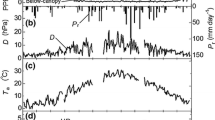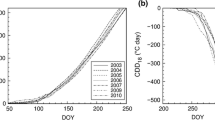Abstract
The physiological nature of canopy resistance was studied by comparing the stomatal and canopy resistance of a 10-m high Douglas-fir forest. Stomatal resistance of the needles was measured using porometry, while the canopy resistance was calculated using energy balance/Bowen ratio measurements of evapotranspiration. A typical steady increase in the forest canopy resistance during daytime hours, even at high soil water potentials, was observed. A similar trend in the stomatal resistance indicated that increasing canopy resistance during the daytime was caused by gradually closing stomata. During a dry period when soil water potentials declined from 0 to −10.5 bars, the mean daytime value of canopy resistance increased in proportion to the mean daytime value of the stomatal resistance. Values of canopy resistance calculated from stomatal resistance and leaf area index measurements agreed well with those calculated from energy balance measurements. The dependences of stomatal resistance on light, vapour pressure deficit, twig and soil water potentials art summarized.
Similar content being viewed by others

References
Black, T. A. and McNaughton, K. G.: 1971, ‘Psychrometric Apparatus for Bowen-Ratio Determination over Forests’, Boundary-Layer Meteorol. 2, 246–254.
Black, T. A., Tang, P. A., Tan, C. S., Curtis, J. R., and McNaughton, K. G.: 1974, Measurement Techniques Used in Forest Hydrometeorology, Final Report to the Pacific Forest Research Centre, Department of the Environment, Victoria, B.C.
Black, T. A., Tanner, C. B., and Gardner, W. R.: 1970, ‘Evapotranspiration from a Snap Bean Crop’, Agron, J. 62, 66–69.
Brady, R. A., Goltz, S. M., Powers, W. L., and Kanemasu, E. T.: 1975, ‘Relation of Soil Water Potential to Stomatal Resistance of Soybean’, Agron. J. 67, 97–99.
Federer, C. A.: 1975, ‘Evapotranspiration’, Reviews of Geophysics and Space Physics 13(3), 442–445, 487–494.
Gash, J. H. C. and Stewart, J. B.: 1975, ‘The Average Surface Resistance of a Pine Forest Derived from Bowen-Ratio Measurements’, Boundary-Layer Meteorol. 8, 453–464.
Jarvis, P.: 1975, Water Transfer in Plants, in D. A. de Vries and N. H. Afgan (eds.), Heat and Mass Transfer in the Biosphere. I. Transfer Processes in Plant Environment, Scripta Book Co., Wash., D.C.
McNaughton, K. G. and Black, T. A.: 1973, ‘A Study of Evapotranspiration from a Douglas-fir Forest Using the Energy Balance Approach’, Water Resour. Res. 9, 1579–1590.
Monteith, J. L.: 1965, ‘Evaporation and Environment’, Symp. Soc. Exp. Biol. 19, 205–234.
Monteith, J. L., Szeicz, G., and Waggoner, P. E.: 1965, ‘The Measurement and Control of Stomatal Resistance in the Field’, J. Appl. Ecol. 2, 345–355.
Scholander, P. F., Hammel, H. T., Bradstreet, E. D., and Hemmingsen, E. A.: 1965, ‘Sap Pressure in Vascular Plants’, Sci. 148, 339–346.
Schulze, E.-D., Lange, O. L., Evanari, M., Kappen, L., and Buschbom, U.: 1974, ‘The Role of Air Humidity and Leaf Temperature in Controlling Stomatal Resistance of Prunus armeniaca L. under Desert Conditions. I. A Simulation of the Daily Course of Stomatal Resistance’. Oecologia (Berl.) 17, 159–170.
Stewart, J. B. and Thom, A. S.: 1973, ‘Energy Budgets in a Pine Forest’, Quart. J. Roy. Meteorol Soc. 99, 154–170.
Szeicz, G. and Long, I. F.: 1969, ‘Surface Resistance of Crop Canopies’, Water Resour. Res. 5, 622–633.
Szeicz, G., van Bavel, C. H. M., and Takami, S.: 1973, ‘Stomatal Factor in the Water Use and Dry Matter Production by Sorghum’, Agr. Meteorol. 12, 361–389.
Tang, P. A., McNaughton, K. G., and Black, T. A.: 1974, ‘Inexpensive Diode Thermometry Using Integrated Circuit Components’, Can. J. Forest Res. 4, 250–254.
Tang, P. A., McNaughton, K. G., andBlack, T. A.: 1976, Precision Electronic Integrator for Environmental Measurement, Transactions of the ASAE (in press).
Tanner, C. B. and Fuchs, M.: 1968, ‘Evaporation from Unsaturated Surfaces: a Generalized Combination Method’, J. Geophys. Res. 73, 1299–1303.
Thom, A. S.: 1972, ‘Momentum, Mass and Heat Exchange of Vegetation’, Quart. J. Roy. Meteorol. Soc. 98, 124–134.
Turner, N. C., Peterson, F. C. C., and Wright, W. H.: 1969, An Aspirated Diffusion Porometer for Field Use, Conn. Agr. Exp. Sta. Soils Bull. No. XXIX, 1–7.
van Bavel, C. H. M.: 1967, ‘Changes in Canopy Resistance to Water Loss from Alfalfa Induced by Soil Water Depletion’, Agr. Meteorol. 4, 165–176.
Author information
Authors and Affiliations
Rights and permissions
About this article
Cite this article
Tan, C.S., Black, T.A. Factors affecting the canopy resistance of a Douglas-fir forest. Boundary-Layer Meteorol 10, 475–488 (1976). https://doi.org/10.1007/BF00225866
Received:
Issue Date:
DOI: https://doi.org/10.1007/BF00225866



